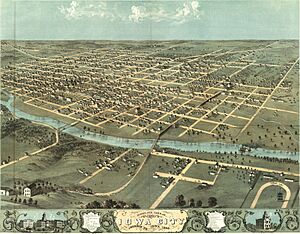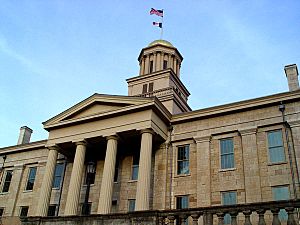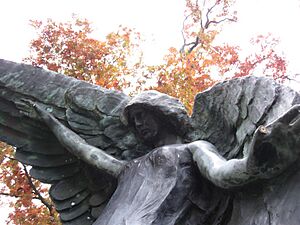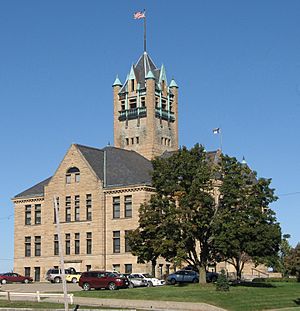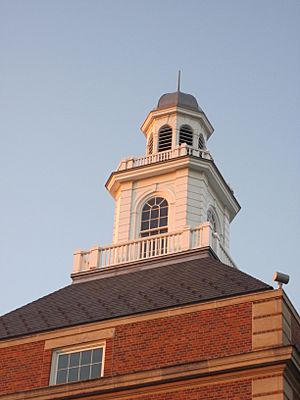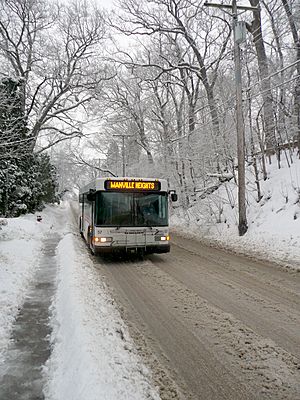Iowa City, Iowa facts for kids
Quick facts for kids
Iowa City, Iowa
|
||
|---|---|---|
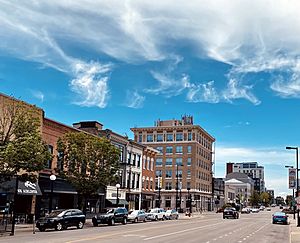
Downtown Iowa City, June 2021
|
||
|
||
| Nickname(s):
Athens of Iowa
|
||

Location within Johnson County and Iowa
|
||
| Country | United States | |
| State | Iowa | |
| County | Johnson | |
| Government | ||
| • Type | Council–manager | |
| Area | ||
| • City | 26.19 sq mi (67.82 km2) | |
| • Land | 25.65 sq mi (66.43 km2) | |
| • Water | 0.54 sq mi (1.40 km2) | |
| Elevation | 668 ft (203.6 m) | |
| Population
(2020)
|
||
| • City | 74,828 | |
| • Estimate
(2023)
|
75,678 | |
| • Rank | 5th in Iowa | |
| • Density | 2,917.50/sq mi (1,126.47/km2) | |
| • Metro | 171,491 | |
| • Demonym | Iowa Citian | |
| Time zone | UTC−6 (CST) | |
| • Summer (DST) | UTC−5 (CDT) | |
| ZIP codes |
52240, 52242 – 52246
|
|
| Area code | 319 | |
| FIPS code | 19-38595 | |
| GNIS feature ID | 0457827 | |
| Website | icgov.org | |
Iowa City is the main city in Johnson County, Iowa, United States. In 2020, about 74,828 people lived there. This makes it the fifth-largest city in Iowa. The larger area around Iowa City, including Johnson and Washington counties, has over 171,000 people. This area is also part of a bigger region with Cedar Rapids. Together, this region has almost 500,000 people.
Iowa City is home to the University of Iowa. It was once the capital city of the Iowa Territory and then the first capital of the State of Iowa. The Old Capitol building is a very important historical site. It is located in the middle of the University of Iowa campus. Other popular places to visit include the University of Iowa Art Museum and Plum Grove. Plum Grove was the home of Iowa's first governor.
Contents
History of Iowa City
Iowa City was created by a law on January 21, 1839. Governor Robert Lucas wanted the capital moved. He wanted it closer to the center of the Iowa Territory. The law said: "An Act to locate the Seat of Government of the Territory of Iowa ... as soon as the place is chosen... the commissioners shall lay out a town to be called 'Iowa City'."
Commissioners Chauncey Swan and John Ronalds chose the spot on May 1, 1839. They met near a small town called Napoleon. The next day, they picked a site on cliffs above the Iowa River. They put a stake in the ground to mark the center of the new capital city. Commissioner Swan described the spot as a natural "amphitheater."
By June 1839, the town was planned out. It stretched from Brown Street in the north to Burlington Street in the south. It went from the Iowa River east to Governor Street.
Iowa City became the official capital in 1841. This was after construction on the capitol building started. The capitol building was finished in 1842. The last four territorial legislatures met there. The first six Iowa General Assemblies also met there. In 1857, the state capital moved to Des Moines.
The Old Capitol Building
John F. Rague is known for designing the Territorial Capitol Building. He had also designed the Illinois capitol in 1837. He started designing Iowa's capitol in 1839. He left the project after five months. He said his design was not being followed. But the building still looks a lot like the Illinois capitol. This shows he had a big impact on the final design.
The first stone of the Old Capitol Building was placed on July 4, 1840. Iowa City was the third and last capital of the Iowa Territory. The last four territorial legislatures met in the Old Capitol. On December 28, 1846, Iowa became the 29th state. Iowa City was named the state capital. The government met in the Old Capitol Building.
In the early 1970s, the Old Capitol was fixed up. University offices moved out. Most of the main rooms were made to look like they did when Iowa City was the capital. In November 2001, the cupola (the small dome on top) caught fire. This happened during repairs to its gold leaf dome. The cupola was destroyed, and the building was badly damaged. In 2006, after a lot of work, the building opened again. It is now the Old Capitol Museum. It is also used for speeches, talks, and performances.
Oakland Cemetery
Oakland Cemetery was given to the people of Iowa City in 1843. It started as one block square. Over the years, it grew to 40 acres. It is a city cemetery supported by taxes. The staff works hard to keep it well-maintained.
Many important people from Iowa's history are buried here. These include Robert E. Lucas, Iowa's first territorial governor. Also, Samuel J. Kirkwood, who was governor during the Civil War. University presidents and the famous Iowa City historian Irving B. Weber are also buried there.
The cemetery is also home to the "Black Angel" monument. This is an 8.5-foot-tall statue for the Feldevert family. It was put up in 1912. Over time, its color changed from golden bronze to black. This led to many myths and legends about it.
University of Iowa Founding
The University of Iowa was founded in 1847. Today, it offers over 100 areas of study. About 31,112 students attend the university. It has a medical school and one of the largest university-owned hospitals. This hospital provides care in 16 medical areas. The University of Iowa College of Law is also located here.
1970 Protests
The spring of 1970 was a difficult time for college campuses. On April 30, President Richard Nixon announced that U.S. forces would enter Cambodia. This was because of a recent change in government there. Students across the country protested this expansion of the Vietnam War. On May 4, the National Guard shot students at Kent State University. Four students were killed and nine were hurt. This caused protests everywhere.
Anti-war protests were not new to Iowa City. They had been happening throughout the 1960s. But spring 1970 was different. After the Kent State shootings, students marched to the National Guard Armory. They broke windows there and in some downtown stores. The City Council gave the mayor power to set a curfew.
On May 6, students boycotted classes. That night, about 400 people slept in front of the Old Capitol. Also that night, about 50 people broke into the Old Capitol. They set off a smoke bomb. The protesters left when asked. Early Friday morning, President Boyd asked for students on the Pentacrest to be arrested. But the next day, he said he regretted the arrests. He said he had received wrong information. On May 8, President Boyd canceled the annual Governor's Day ROTC event. On Friday and Saturday, a National Guard helicopter flew over the Pentacrest.
Early Saturday, May 9, a building called the Old Armory Temporary (O.A.T.) burned down. This building, also known as "Big Pink," housed the writing lab. It was next to the Old Armory. People said O.A.T. was on a list of buildings to be burned. This was probably because it was in poor condition. There was a second, smaller fire later that Saturday evening.
By Sunday morning, President Boyd gave students a choice to leave. Classes were not canceled. But students could leave and take the grade they had at that time.
2006 Tornadoes
On the evening of April 13, 2006, a strong tornado hit Iowa City. It caused a lot of damage to buildings. Many people, including university students, had to leave their homes. This was the first tornado ever recorded to directly hit the city. Luckily, no one was seriously hurt in Iowa City.
Several businesses were destroyed. The 134-year-old Saint Patrick's Catholic Church was badly damaged. Most of its roof was gone. The church was later torn down. The downtown area and eastern neighborhoods also had damage.
Many sorority houses were destroyed. The Alpha Chi Omega house was almost completely ruined. No one was hurt there. The building was later removed. People from all over the state helped clean up. The total damage was estimated at $12 million.
2008 Flood
In June 2008, the Coralville Reservoir overflowed. As a result, Iowa City and the University of Iowa were hit by a huge flood. The Iowa River rose to record levels. This caused a lot of damage and forced people to leave their homes.
University officials said that up to 19 buildings were affected. People worked hard to move items from the main library. Many volunteers built a large levee (a wall to hold back water) near the building. About $300 million worth of art from the university was secretly moved to Chicago. This happened before the art areas were flooded.
On Friday, June 13, university employees were told to stay home. Travel was strongly discouraged. One city statement advised, "If you live in east Iowa City, stay in east Iowa City; if you live in west Iowa City, stay in west Iowa City." The Burlington Street bridge was the only one open to connect the two sides of the river.
On Saturday, June 14, the university began to shut down its main power plant. This was to prevent damage. Backup power units kept essential services running. Water started touching the Park Street bridge. The Army Corps of Engineers drilled holes in the bridge. This allowed trapped air to escape. Mayor Regenia Bailey also set a curfew. This restricted people from being near flooded areas at night.
2010s and Environmental Issues
On October 4, 2019, a Friday climate school strike took place in Iowa City. Greta Thunberg was there. Young people protested against coal power.
Geography and Climate
Iowa City is in eastern Iowa, along the Iowa River. It is located on Interstate 80. This is about 60 miles west of the Quad Cities.
The city covers about 25.28 square miles. Most of this is land, with a small amount of water. The elevation at the Iowa City Municipal Airport is 668 feet above sea level.
Iowa City has a humid continental climate. This means it has hot summers. Average monthly temperatures range from about 22.8°F in January to 75.8°F in July. Rainfall is lowest in winter. It peaks from May to August, with June being the wettest month.
Showers and thunderstorms are common from May to September. They can be severe, especially from May to July. In winter, snowfall is moderate. It can sometimes be heavy in single storms. Snow cover is not always continuous. Iowa City has a lower risk of tornadoes compared to areas further south.
| Climate data for Iowa City, Iowa (1991–2020 normals, extremes 1893–present) | |||||||||||||
|---|---|---|---|---|---|---|---|---|---|---|---|---|---|
| Month | Jan | Feb | Mar | Apr | May | Jun | Jul | Aug | Sep | Oct | Nov | Dec | Year |
| Record high °F (°C) | 68 (20) |
76 (24) |
88 (31) |
93 (34) |
105 (41) |
105 (41) |
109 (43) |
108 (42) |
101 (38) |
94 (34) |
81 (27) |
74 (23) |
109 (43) |
| Mean maximum °F (°C) | 51.8 (11.0) |
56.8 (13.8) |
72.7 (22.6) |
82.3 (27.9) |
88.6 (31.4) |
93.2 (34.0) |
95.4 (35.2) |
94.7 (34.8) |
91.0 (32.8) |
84.3 (29.1) |
69.3 (20.7) |
55.8 (13.2) |
97.2 (36.2) |
| Mean daily maximum °F (°C) | 29.3 (−1.5) |
34.3 (1.3) |
47.9 (8.8) |
61.6 (16.4) |
72.2 (22.3) |
81.0 (27.2) |
84.4 (29.1) |
82.4 (28.0) |
76.3 (24.6) |
63.2 (17.3) |
47.5 (8.6) |
34.4 (1.3) |
59.5 (15.3) |
| Daily mean °F (°C) | 20.5 (−6.4) |
24.9 (−3.9) |
37.2 (2.9) |
49.4 (9.7) |
60.6 (15.9) |
70.0 (21.1) |
73.5 (23.1) |
71.3 (21.8) |
64.0 (17.8) |
51.6 (10.9) |
37.5 (3.1) |
26.0 (−3.3) |
48.9 (9.4) |
| Mean daily minimum °F (°C) | 11.6 (−11.3) |
15.5 (−9.2) |
26.6 (−3.0) |
37.1 (2.8) |
48.9 (9.4) |
59.0 (15.0) |
62.5 (16.9) |
60.2 (15.7) |
51.6 (10.9) |
39.9 (4.4) |
27.6 (−2.4) |
17.5 (−8.1) |
38.2 (3.4) |
| Mean minimum °F (°C) | −9.5 (−23.1) |
−3.1 (−19.5) |
8.1 (−13.3) |
24.7 (−4.1) |
36.0 (2.2) |
48.9 (9.4) |
54.9 (12.7) |
52.5 (11.4) |
38.9 (3.8) |
26.1 (−3.3) |
13.0 (−10.6) |
−1.6 (−18.7) |
−13.6 (−25.3) |
| Record low °F (°C) | −32 (−36) |
−32 (−36) |
−17 (−27) |
10 (−12) |
24 (−4) |
37 (3) |
40 (4) |
38 (3) |
20 (−7) |
4 (−16) |
−6 (−21) |
−27 (−33) |
−32 (−36) |
| Average precipitation inches (mm) | 1.14 (29) |
1.40 (36) |
2.33 (59) |
3.86 (98) |
5.05 (128) |
5.49 (139) |
4.56 (116) |
4.32 (110) |
3.45 (88) |
3.00 (76) |
2.27 (58) |
1.60 (41) |
38.47 (977) |
| Average snowfall inches (cm) | 7.6 (19) |
7.5 (19) |
3.2 (8.1) |
0.5 (1.3) |
0.0 (0.0) |
0.0 (0.0) |
0.0 (0.0) |
0.0 (0.0) |
0.0 (0.0) |
0.4 (1.0) |
1.1 (2.8) |
7.2 (18) |
27.5 (70) |
| Average extreme snow depth inches (cm) | 7.4 (19) |
6.4 (16) |
2.8 (7.1) |
0.5 (1.3) |
0.0 (0.0) |
0.0 (0.0) |
0.0 (0.0) |
0.0 (0.0) |
0.0 (0.0) |
0.1 (0.25) |
1.0 (2.5) |
4.6 (12) |
9.7 (25) |
| Average precipitation days (≥ 0.01 in) | 7.4 | 7.0 | 8.7 | 11.4 | 12.6 | 11.2 | 8.8 | 8.9 | 8.4 | 9.0 | 7.6 | 8.2 | 109.2 |
| Average snowy days (≥ 0.1 in) | 4.0 | 3.5 | 1.5 | 0.3 | 0.0 | 0.0 | 0.0 | 0.0 | 0.0 | 0.2 | 0.6 | 4.0 | 14.1 |
| Source: NOAA | |||||||||||||
People and Demographics
| Historical populations | ||
|---|---|---|
| Year | Pop. | ±% |
| 1850 | 1,250 | — |
| 1860 | 5,214 | +317.1% |
| 1870 | 5,914 | +13.4% |
| 1880 | 7,123 | +20.4% |
| 1890 | 7,016 | −1.5% |
| 1900 | 7,987 | +13.8% |
| 1910 | 10,091 | +26.3% |
| 1920 | 11,267 | +11.7% |
| 1930 | 15,340 | +36.1% |
| 1940 | 17,182 | +12.0% |
| 1950 | 27,212 | +58.4% |
| 1960 | 33,443 | +22.9% |
| 1970 | 46,850 | +40.1% |
| 1980 | 50,508 | +7.8% |
| 1990 | 59,735 | +18.3% |
| 2000 | 62,220 | +4.2% |
| 2010 | 67,862 | +9.1% |
| 2020 | 74,828 | +10.3% |
| Source: and Iowa Data Center (PDF) Source: |
||
Iowa City is often called a "college town." This is because it is home to the University of Iowa. The number of people in the city grows when the university is in session.
In 2010, about 58% of adults had a college degree or higher. About 80% of people were white, not Hispanic or Latino. About 6% were Asian, and 5.8% were Black. The average household income was $41,410. This was about $10,000 less than the state average.
Population in 2020
In 2020, there were 74,828 people living in Iowa City. There were 30,291 households. About 20% of households had children under 18. The average age in the city was 27.1 years. About 21% of people were under 20. About 24% were between 20 and 24.
The city's population was 72.5% White. It was 10.2% Black or African American. About 7.3% were Asian. People of Hispanic or Latino background made up 7.3% of the population.
Surrounding Area
The Iowa City Metropolitan Statistical Area includes Johnson and Washington counties. In 2010, this area had 152,586 people.
Iowa City is connected to Coralville to the northwest. University Heights is completely inside Iowa City. Other nearby towns include Tiffin, North Liberty, Solon, and Hills.
The Iowa City area and the nearby Cedar Rapids area form a larger region. This region is called the Iowa City-Cedar Rapids (ICR) Corridor. It has over 450,000 people.
Economy and Jobs
Iowa City is home to the University of Iowa Hospitals and Clinics (UIHC). This is the only full-service medical center in the state. The Holden Comprehensive Cancer Center in Iowa City is a special cancer treatment center. It is one of fewer than 60 in the country.
ACT, which creates college tests, has its main office in Iowa City.
Top Employers
Here are the top employers in Iowa City, based on a 2018 report:
| # | Employer | # of Employees |
|---|---|---|
| 1 | University of Iowa and University of Iowa Hospitals and Clinics | 29,705 |
| 2 | Iowa City VA Medical Center | 2,150 |
| 3 | Iowa City Community School District | 1,575 |
| 4 | Mercy Hospital | 1,325 |
| 5 | ACT Inc. | 1,187 |
| 6 | Procter & Gamble | 1,084 |
| 7 | Hy-Vee | 1,012 |
| 8 | City of Iowa City | 931 |
| 9 | Pearson | 775 |
| 10 | Johnson County | 609 |
Arts and Culture
The Iowa Avenue Literary Walk is a special tribute to the city's writing history. It has bronze panels with words from authors. These authors all have connections to Iowa. There are 49 authors and playwrights featured.
In 2008, UNESCO named Iowa City the world's third City of Literature. This means it is part of a special network of creative cities. It was the only American city to get this honor until 2017.
The Old Capitol Cultural District was one of the first certified Cultural Districts in Iowa. It includes the University of Iowa Pentacrest and other historic areas.
Cultural Events
Iowa City has many cultural events. It is known for its strong literary history. It is home to the Iowa Writers' Workshop. Many famous authors have graduated from this program. These include John Irving and Flannery O'Connor. The city also has a leading Non-Fiction Writing Program.
Iowa City also hosts many events in its Summer of the Arts program. These include the Iowa City Jazz Festival and the Iowa Arts Festival. There are also free outdoor movies and free concerts. These happen every Friday night in the pedestrian mall.
The Iowa City Book Festival started in 2009. It features readings from well-known authors. It also has other literature-themed events.
Downtown Iowa City has several arts venues. These include the historic Englert Theatre for live music. Riverside Theatre is a professional theater company. It has an outdoor Shakespeare festival. FilmScene is a non-profit movie theater.
The Englert Theatre also puts on the Mission Creek Festival each spring. This festival focuses on community events and literary programs. Witching Hour happens each fall. It explores creative processes and new works.
Local Landmarks
- Hancher Auditorium hosts national theater, dance, and music shows. It was damaged in the Iowa flood of 2008. It was rebuilt further from the river and reopened in 2016.
- Hamburg Inn No. 2 is a popular stop for political candidates. It was shown in the TV show The West Wing. Many U.S. Presidents have visited it. It is famous for its "pie shakes."
- Oakland Cemetery has graves of important local people. It also has the "Black Angel" statue.
- Plum Grove Historic House was the home of Robert Lucas. He was Iowa's first territorial governor.
- Moffitt cottages are unique houses found around eastern Iowa City.
- Prospect Hill
- Ned Ashton House was built in 1947 by engineer Ned Ashton. It is now a popular place for events. It can hold up to 100 people.
Pedestrian Mall
City Plaza, often called the Pedestrian Mall or Ped Mall, is a gathering place. Students and locals come here. It draws big crowds for summer events. These include the Friday Night Concert Series and the Jazz Festival. The Ped Mall has restaurants, shops, and the Iowa City Public Library. It is known for its local artists and musicians.
Education
The Iowa City Community School District runs the public schools. Iowa City High School, Iowa City West High School, and Liberty High School are the three public high schools. Iowa City also has a private school, Regina Catholic Education Center.
Iowa City is home to The University of Iowa. It also has a branch of Kirkwood Community College. The Iowa City Japanese School offers Japanese language classes for Japanese students.
Sports
Iowa City is home to the University of Iowa's sports teams, the Iowa Hawkeyes. They are part of the Big Ten Conference. The football team plays at Kinnick Stadium. Basketball, volleyball, wrestling, and gymnastics teams compete at Carver-Hawkeye Arena. Many Hawkeyes football players go on to play in the NFL. These include Marshall Yanda and George Kittle. Kirk Ferentz is the longest-serving head coach in NCAA FBS football.
Iowa City's three public high schools are City, West, and Liberty. They are members of the Mississippi Valley Conference. Regina competes in the River Valley Conference.
Parks and Recreation
Iowa City has many public spaces. Most are run by the City of Iowa City Parks & Recreation Department. Some are owned by the University of Iowa. Others are held by groups like the Bur Oak Land Trust.
Some important parks include Waterworks Prairie Park. This is the largest park at 231 acres. City Park has sports fields, a pool, and picnic areas. Hickory Hill Park is a large wooded park. Hubbard Park is a green space near the university.
There are three golf courses in the city. Finkbine Golf Course is owned by the University of Iowa. Pleasant Valley Golf Course is public. Elks Lodge Country Club is a private course.
The Iowa City Kickers Soccer Complex has over 17 soccer fields. Napoleon Park has 8 baseball diamonds. Bobby Oldis Fields also has 8 baseball diamonds. Hawkeye Recreation Fields has 12 soccer fields and other courts. The Bill and Jim Ashton Cross Country Course is a special course for cross country running. The University of Iowa also has indoor sports facilities.
Iowa City has many miles of cycling trails. There are trails along the Iowa River and other creeks. The Iowa City trail system connects to nearby towns like Coralville. Both Iowa City and the University of Iowa have been recognized as "bicycle friendly."
Media
Three radio stations are based at the University of Iowa. WSUI 910 AM is a public radio station. KSUI 91.7 FM plays classical music. KCCK-FM is Iowa's only Jazz station. KRUI 89.7 FM is run by university students.
iHeartMedia owns two commercial radio stations in the area. KXIC 800 AM is a news/talk station. KKRQ 100.7 FM plays classic rock. KCJJ 1630 AM is an independent station. It plays talk radio and music. It also broadcasts high school sports and NASCAR races.
Iowa City is part of a larger TV market. Two TV stations are licensed to Iowa City. KIIN channel 12 is a PBS station. KWKB channel 20 shows Court TV Mystery. KCRG-TV 9, an ABC station from Cedar Rapids, has a news office in downtown Iowa City.
Mediacom, a local cable TV company, provides several public access channels. These include City Channel 4 and the Iowa City Public Library Channel.
Two daily newspapers are published in Iowa City. The Iowa City Press-Citizen is published six days a week. The Daily Iowan is an independent newspaper from the University of Iowa. It publishes Monday through Friday during classes. The Gazette from Cedar Rapids also has a news office in Iowa City.
Little Village is a free magazine that covers Iowa City and Cedar Rapids.
Transportation
Iowa City has a small airport for private planes. It is called the Iowa City Municipal Airport. The Eastern Iowa Airport, about 20 miles away, serves Iowa City and Cedar Rapids with regular passenger flights.
Interstate 80 runs east–west along the north side of Iowa City. U.S. Highway 218 and Iowa Highway 27 (the Avenue of the Saints) bypass Iowa City to the west. U.S. Highway 6 and Iowa Highway 1 also go through Iowa City.
Iowa City is served by freight trains. The historic Iowa City Depot is no longer used for trains. It has been changed into an office building.
In 2009, Iowa City was ranked high for people who walked to work. In 2013, about 11% of commuters in Iowa City walked to work.
Buses
Iowa City Transit, Coralville Transit, and the University of Iowa's Cambus system provide public transportation. A bus service called the 380 Express connects to Cedar Rapids. Intercity buses stop at the Court Street Transportation Center or the Coralville Transit Intermodal Facility.
Cycling
Iowa City has many paved bicycle paths. These are especially along the Iowa River. Some main roads also have bike lanes. Both Iowa City and the University of Iowa have been given "silver" status as bicycle friendly.
Notable People
- Nancy C. Andreasen, psychiatrist and professor at University of Iowa
- Todd Blodgett, worked for the White House (Reagan-Bush)
- George Washington Ball, former Iowa City mayor and state politician
- Janusz Bardach, author and plastic surgeon
- Bob Barr, former Georgia congressman
- Brian Bell, guitarist for the band Weezer
- Moses Bloom, former Iowa City mayor, first Jewish mayor of a major American city
- Eleanor Hoyt Brainerd, novelist
- Greg Brown, folk musician
- Ethan Canin, writer
- Thomas R. Cech, 1989 Nobel Prize winner in chemistry
- Harry Chase, 19th-century marine painter
- Eli P. Clark, railroad worker
- James Claussen, lithographer and painter
- Iris DeMent, musician
- Peter A. Dey, former Iowa City Mayor, engineer, and banker
- Edward M. Doe, Arizona judge
- Benjamin Edwards, visual artist
- Albert Erives, biologist
- Tim Dwight, NFL player
- Kenny Fields, former NBA player
- Jim Foster, creator of the Arena Football League
- Dan Gable, Olympic gold medalist and wrestling coach
- Janet Guthrie, race car driver, first woman in Indianapolis 500
- Oscar Hahn, author
- Andy Haman, bodybuilding champion
- Mary Eunice Harlan, daughter-in-law of Abraham Lincoln
- Hill Harper, actor
- Jay Hilgenberg, football player for the Chicago Bears
- Rob Hogg, Iowa State Senate Minority Leader
- John P. Irish, Iowa and California editor
- Zach Johnson, golfer, 2007 Masters champion
- Nate Kaeding, NFL kicker
- Carol Kelso, Wisconsin State Assembly member
- Seung Min Kim, journalist
- Alex Ko, Broadway actor
- Alan Larson, diplomat and ambassador
- Diego Lasansky, visual artist
- Mauricio Lasansky, visual artist
- Tomas Lasansky, visual artist
- Laura Leighton, actress
- Helen Lemme, local activist
- Elinor Levin, Iowa House of Representatives member
- Janet Lilly, dancer and choreographer
- Jean Hall Lloyd-Jones, state legislator
- Nia Long, actress
- Melissa Ludtke, editor
- Dan McCarney, college football coach
- James Alan McPherson, writer
- Corine Mauch, Mayor of Zürich
- Christopher C. Miller, Acting United States Secretary of Defense
- Jim Miller, football player
- Julie Miller, harness racing driver and trainer
- Phil Morris, actor
- Mary Neuhauser, former Iowa City Mayor and state legislator
- Stephanie Novacek, opera singer
- Dan Perkins aka Tom Tomorrow, political cartoonist
- Joseph M. Petrick, writer and director
- Jason Reeves, singer-songwriter
- Marilynne Robinson, Pulitzer Prize-winning author
- Nate Ruess, lead singer of the band Fun
- Paul Schedl, molecular biologist
- Phyllis Somerville, actress
- Russell Stover, candy maker
- David Strackany, folk singer-songwriter
- John T. Struble, pioneer builder and farmer
- Elizabeth Tate, civil rights advocate
- James Van Allen, physicist and astronomer
- Michael Wacha, MLB pitcher
- Zach Wahls, LGBT activist and state legislator
- Louis J. Wilde, former mayor of San Diego
- Grant Wood, artist who painted "American Gothic"
- Joey Woody, world champion sprinter
- Bart Yates, writer
See also
 In Spanish: Iowa City para niños
In Spanish: Iowa City para niños





